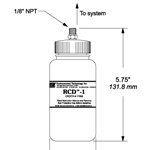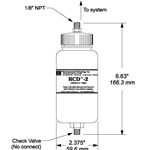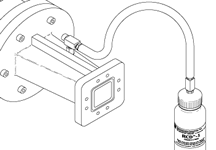Home > Products > RCD–1 and RCD–2 Passive Dehydrator / 1 cu/ft drying capacity
Benefits & Features
- Keep waveguide and coax dry
- Low Cost
- Reliable
- No power required
- Long desiccant life
- Simple Installation
- Desiccant indicates when to regenerate/replace
- Self pressurizing (RCD–2 only)



Description
Although the RCD–1 Passive Dehydrator contains no moving parts, and the Patent Pending RCD–2 Passive Dehydrator contains just one moving part, they both dry waveguide and coax in fixed, mobile and solar powered systems with volumes up to one cubic foot. It eliminates the need to operate pressurization equipment from emergency power when used as a backup for mechanical systems. The RCD–1 and RCD–2 may also be used to protect equipment from moisture damage during transit and unheated storage.
The RCD–1 contains desiccant sealed in a pressure-tight container. It provides a 1/8" male NPT fitting. Gas diffusion insures that the desiccant is exposed to any water vapor present in the system. Unlike mechanically pressurized systems, the RCD–1 works best when the waveguide or coax system is tightly sealed.
The RCD–2 provides a 1/8" male NPT fitting. Gas diffusion insures that the desiccant is exposed to any water vapor present in the system. The RCD–2 works best when the waveguide or coax system is tightly sealed.
The RCD–2 uses ambient temperature variations for pressurization. When the temperature drops, the system pressure becomes negative which opens the RCD–2's check valve. Ambient air is drawn in through the desiccant. Internal pressure increases with ambient temperature, closing the check valve and pressurizing the system.
The RCD–1 and RCD–2 employ a blend of silica gel and activated alumina desiccants. This combination provides effective drying while indicating when desiccant regeneration is required. The desiccant can either be replaced or regenerated by heating in a convection oven. Depending upon the system volume and tightness along with environmental conditions at the site, the desiccant lasts 12 to 18 months, or longer, before requiring regeneration or replacement. Conditions such as a leaky system and damp climate may reduce desiccant longevity.
For complete information describing its application, installation and features, please contact Customer Service or check on the web at www.networketi.com.
Specifications
| Maximum dehydrated volume | One cubic foot |
| Desiccant replacement/regeneration interval | Typically 12 to 18 months, or more |
| Rated pressure | Up to 8 psig |
| Maximum pressure | 20 psig |
| Desiccant system | Blend of activated alumina and silica gel that indicates when service is required |
| Check valve sensitivity (RCD–2) | Nominally 0.1 psig |
In this section:



